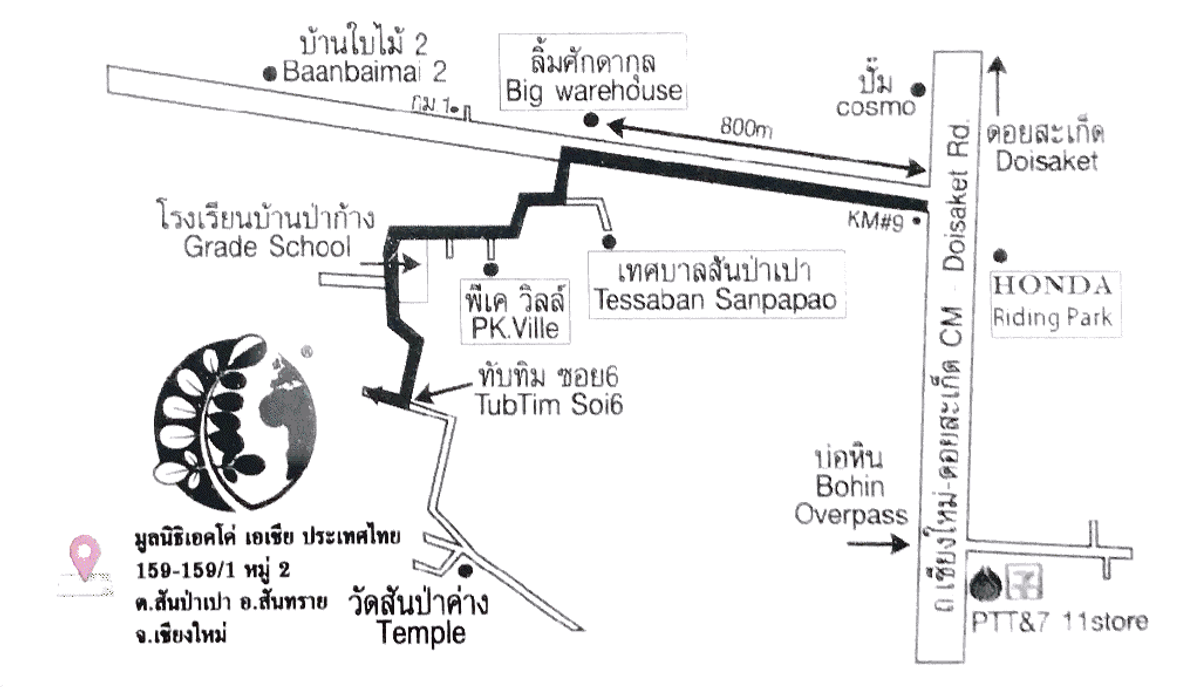This article is from ECHO Asia Note # 41.
A New Chapter for ECHO Asia
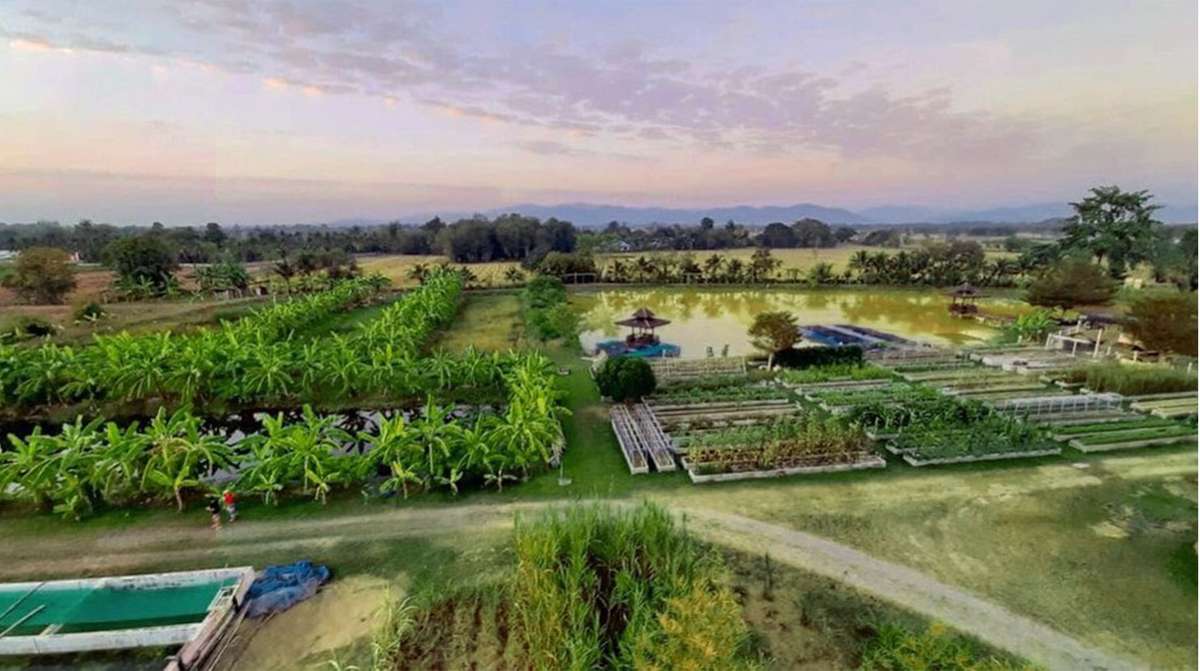
With a new decade upon us, the ECHO Asia team is pleased to highlight the next chapter in its engagement with the Asia regional network. Many of you are well aware of the goings on of ECHO Asia, but for some it may come as news that we have launched a new farm site. We are therefore eager to publicize to our network the opening of the ECHO Asia Small Farm Resource Center & Seed Bank or ‘ECHO Asia Farm’ (Fig. 1). With this new opportunity ECHO Asia is pleased to share this occasion for growth and expansion.
Two years ago ECHO Asia was blessed beyond measure through the gracious donation of a beautiful tract of land, located just 25 minutes outside of the city of Chiang Mai, Thailand. This 3 hectare (7 acre) parcel of land is located on the site of a former aquaculture enterprise, and has been entrusted to us for the use and benefit of our network partners. We are collectively grateful to God for this blessing, and have chosen to dedicate this site to the service of our network and the farming communities that we ultimately serve.
This ECHO Asia Farm is open to all members of the ECHO network as well as other like-minded individuals and organizations, and it is our hope that each of you may find an opportunity to visit us at some point.
In this article you will find a brief overview of some of the current agricultural practices, crop species, and appropriate technologies that are being showcased on the farm. It is our hope that this farm might become a regional hub for sustainable agriculture practices and appropriate technologies, delivering high-impact trainings for improved food production and livelihoods.
Practices & Technologies Showcased at the ECHO Farm
For over 2 years, the ECHO team here has been working diligently to transform this farm into a living classroom, highlighting a number of practical and innovative resources related to sustainable small-scale agriculture in the tropics. This farm will serve the primary goals of (1) supplying our expanded seed bank with open-pollinated (OP) seeds of locally adapted crops, (2) training of our partners, through the demonstration of low-cost and innovative agricultural practices and technologies, and (3) verification and trialing of new agricultural practices and approaches with potential for small-scale farming communities in Asia. The map in Figure 2 highlights the many different practices and demonstrations currently housed on this new farm.
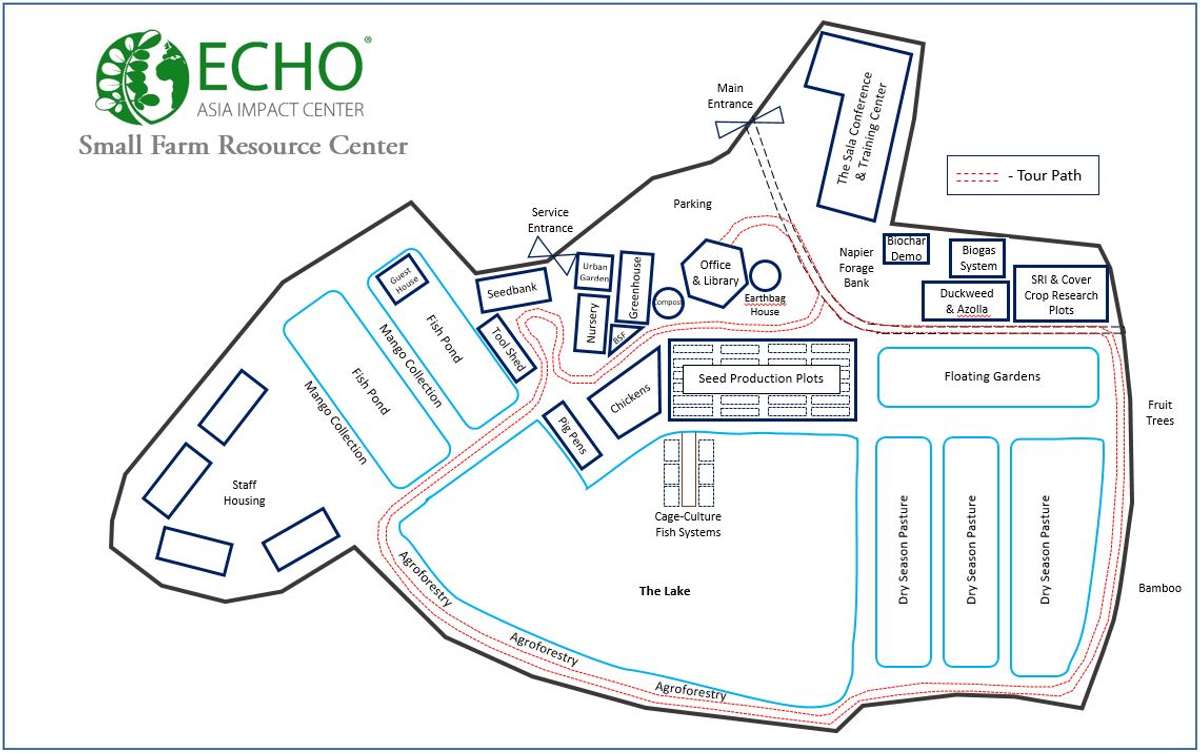
An Expanded Seed Bank
With an expanded seed cold storage facility (Fig. 3), and greater capacity for the production of seed, the new ECHO Asia Seed Bank is home to over 500 active accessions of regionally adapted food crop species, with 200 varieties grown out regularly and available for distribution to the Asia network. The new seed cold room has been expanded to a 40-square meter facility, and the farm currently manages over 60 raised garden beds.
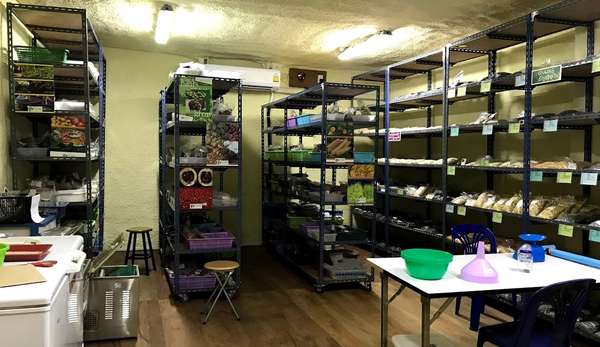
The seed bank infrastructure serves as a demonstration of an appropriate ‘Organization Level Seed Bank’ adaptable to similar organizations. Please note that the ECHO Asia Seed Bank serves its network members operating at the community and grassroots level (community-based service) and does not exist for commercial purposes (for profit).
For a full listing of seed availability through the ECHO Asia Seed Bank, please take a look at our online seed catalog. For ordering trial seed packets or bulk seed, please visit our online store on ECHOcommunity.org. Don’t forget that as a member of the ECHO Network, members are entitled to 10 free trial seed packets per year! Our seed catalog classifies seed varieties according to the following categories:
- Fruits
- Grains
- Herbs & Integrated Pest Management
- Leguminous Trees
- Oil Seeds
- Pulses & Green Manure Cover Crops
- Vegetables
- Seed Bundles (including Green Manure Cover Crop; Nutrition; Salad Garden; Semi-Arid; and Herb/Flower Bundles)
Integrated Crop-Livestock Systems
Critical to any small-scale farming operation is the integration of its crop and livestock systems. This can be achieved in any number of configurations of species and can lead to multiple benefits on both sides. The ECHO Asia Farm uses its feeds resources and transforms livestock manure into usable soil amendments for its crop systems. One of our goals is to minimize the loss of nutrients produced on-farm, while maximizing the production of food and ecosystem services. The following examples are some of the practices happening, on an ongoing basis, at our farm.
Production of On-Farm Feeds
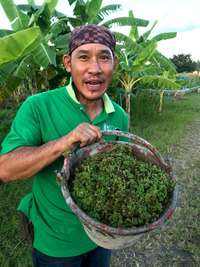
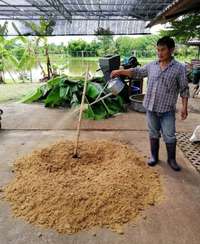
See the ECHO Asia Note called “Rice Hull Gold: 10 On-Farm Uses of Rice Hulls” as one example of integrating a waste product into our daily farm operations.Following ECHO’s longstanding mantra of ‘using what we have, to make what we need,’ it is the goal of our team to maximize our use of on-farm resources. For example, using banana stems, azolla (Fig.4), duckweed, and other forage materials produced on the farm, much of our feed can be made on location in conjunction with locally sourced supplemental materials or ingredients. Feeds are currently being produced on-farm for pigs (Fig. 5), chickens, ruminants, and fish. On-farm feed production also provides opportunity for conversion of what might be considered waste products that might not be suitable for human consumption.
Biogas System
Two models of biogas digesters attached to our pigpens have been recently installed. Each model demonstrates the potential for producing clean methane cooking gas from biodigested pig effluent. In addition to pork production, the remaining slurry after biodigestion is composted and used as a soil amendment for crop production, such as the bananas and forages grown for the feeding of the very same pigs.
Small-Scale Aquaculture Systems
Due to our location on the site of a former aquaculture farm, ECHO Asia takes advantage of the multiple pre-existing fish ponds. Without focusing intensively on
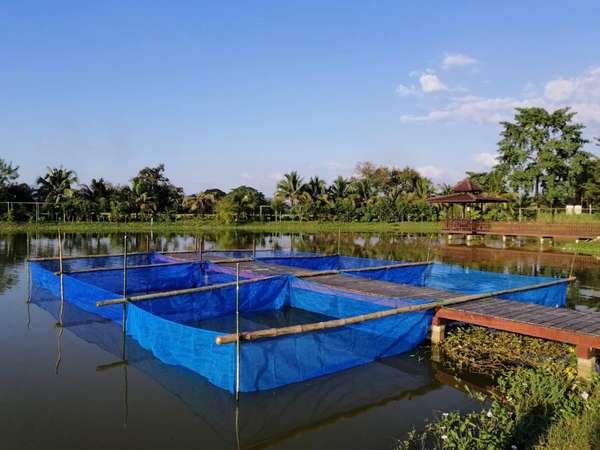
the production of fish, the farm is currently demonstrating some simple ‘cage-culture’ aquaculture systems for the production of Tilapia (Fig 6.). Fish feed is also currently being supplemented with the azolla and duckweed grown right here on the farm. In addition to the consumption of fish, there is also the potential for using fish waste for the production of fish amino acids (FAA) for use as nutrient sprays for crops.
Perennial Food Systems
Agroforestry Walk
Planted only 2 years ago, this area of the farm still has much growing and maturing to do, but is filling in at an impressive rate. To date, the agroforestry walk has been planted with over 70 different species of perennial plants, most of which can be classified as Neglected & Underutilized Species (NUS) or Non-Timber Forest Products (NTFP). This demonstration area aims to highlight the benefits of perennial cropping systems and multi-story planting design. In addition to edible species suited for human consumption, species planted so far include medicinal plants, feeds & forages, mulching materials, construction resources, and even species suited for making on-farm pesticides. Some examples include Fishtail Palm (Caryota mitis), White-Thorned Rattan (Calamus viminalis), Vetiver Grass (Chrysopogon zizanioides), Moringa (Moringa oleifera), Edible Fern (Diplazium esculentum), Neem (Azadirachta indica), Snowflake Tree (Trevesia palmata), Leaf Pepper (Piper sarmentosum) and many more (Fig. 7).

Feeds & Forages Collection
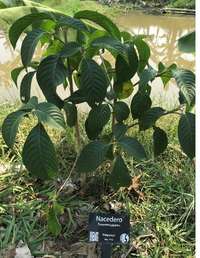
Bananas can be seen growing in large quantity on the ECHO Asia farm, but only represent one of many forage species being demonstrated. The bananas here are produced primarily for their stems and the production of fermented banana stem silage for pigs and chickens, however many other forage varieties are grown that are suited for ruminant livestock such as cattle, goats, and buffalo. These perennial plant species have been selected for their adaptability, drought tolerance, protein content, nitrogen fixing abilities, and palatability for livestock among other things. Some varieties being grown include, Nacedero (Trichanthera gigantea) (Fig. 8), Super Napier Grass (Pennisetum purpureum) (Fig 9) and even Morning Glory (Ipomoea purpurea).
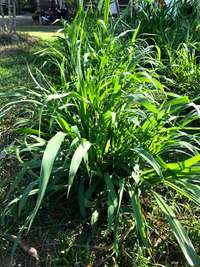
Fruit Tree Production & Propagation
Those familiar with ECHO Asia are aware of the services provided through the seed bank, which has been diligently distributing seed varieties to the Asia network for over 10 years. With the transition to this new site comes not only the opportunity for growth of our seed bank, but also the opportunity for the propagation and distribution of plant seedlings. This includes the potential for providing grafted fruit tree seedlings, plant cuttings, and an expanded plant nursery. Seedlings currently available include Chaya (Cnidoscolus aconitifolius), Katuk (Sauropus androgynus), Perennial Forage Peanut (Arachis glabrata), and more.
Appropriate Technology Demonstrations
Oftentimes good sustainable agriculture practices are only as good as the technologies that make them practical and affordable. For this reason, one will find demonstrated throughout the farm a number of appropriate technologies used in conjunction with the many agriculture practices promoted by ECHO. These technologies tend to be low-cost, made of locally-sourced materials, are practically designed, and suited to a number of different tasks related to water systems, waste recycling, crop production, and post-harvest processing, to name a few.
Biochar Production
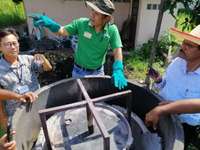
one example of up-cycling an otherwise wasted resource and converting it into something more valuable. While demonstrating the use of small household biochar gasifier cookstoves, 200-liter biochar barrel systems, and a larger retort system, we are able to transform waste products like rice hulls, plant debris, recycled bamboo trellises, and other organic materials into valuable soil amendments for our raised bed seed production plots (Fig. 10).
Biochar Water Filtration
In addition to being used as a soil amendment, our biochar is also being used as a key component in the
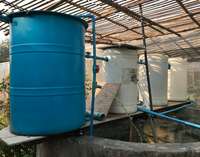
demonstration of a 300 Liter per Day Water Treatment System (Fig. 11). Using a ‘blue barrel’ system with varying gradients of sand (and biochar), microbial pathogens and even synthetic pesticide residues can be removed from drinking water.
Low-Cost Seed Storage Facilities
While our primary ECHO Asia Seed Bank is housed in a larger climate-controlled storage facility, it has always been our desire to provide improved seed storage options at the farm or household level. Therefore, in addition to our own Seed Bank, the farm showcases other options that can be done at low-cost, and in places with no electricity. For this reason we have included the demonstration of some natural building techniques suited for seed storage, such as an earthbag house for seed storage (Fig. 12), andother low-cost sealing options using modified bicycle pump vacuum sealing technology. Various other appropriate technologies related to seed stoage, such as solar seed driers and cleaing technologies, are actively used in the ongoing operation of the Seed Bank.
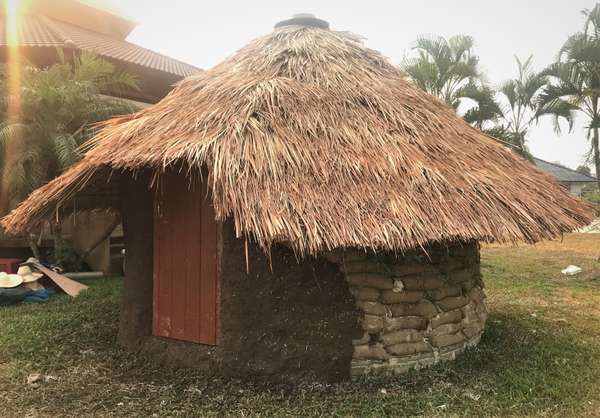
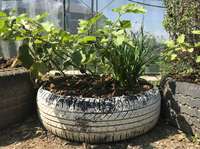
Urban Garden Demonstration
With much of the world migrating toward urban areas, there is increasing need for urban food production practices that are affordable. Using tire gardens (Fig. 13) and other recycled materials, such as buckets, jerry cans, and discarded construction materials, there are a number of innovative options available for food production on balconies, rooftops, and walls.
Adaptive Research
ECHO Asia conducts ‘use-inspired’ research to test, validate, and generate practices and techniques to optimize impact for small-scale farmers. In order to focus our research and take advantage of our comparative strengths, we have opted to keep our research areas within the broader categories of ‘Soils, Seeds, and Feeds’. Research at ECHO Asia always stems from direct interaction with partners, and the needs they have passed along. Listed below are examples of ongoing research in each of the three categories:
Soils - SRI Research Plots and Tropical Cover Crops
Long-term System of Rice Intensification (SRI) plots have been established. These plots will be used for hands-on training opportunities for learning about SRI, but also as observational study plots for comparison of SRI and traditional paddy production (Fig. 14). In addition, these plots are being used to test a number of tropical Green Manure Cover Crop varieties that may be used in fallow periods in rice cropping systems (Fig. 15).
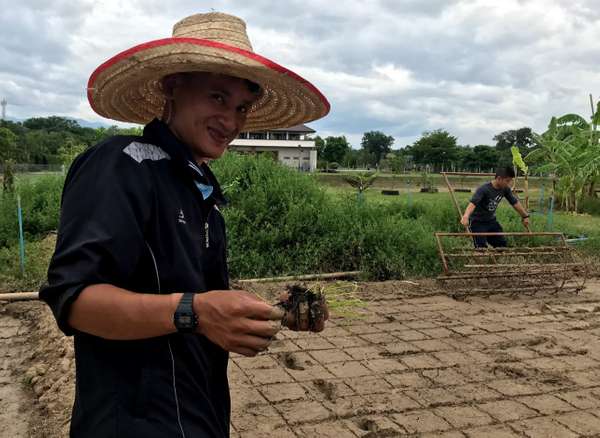
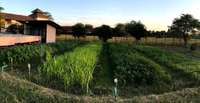
Seeds – Low-Cost Seed Storage Alternatives
Serving as a hub for a regional network of community-level seed banks, it is incumbent on ECHO Asia to continually test and try-out innovative seed storage methods that are affordable and replicable to farm-level seed savers and community-level seed bankers. Ongoing research includes experiments related to low-cost vacuum sealing technologies (Fig. 16), natural earth building techniques for seed storage, and assessments of current seed bank facilities throughout ECHO Asia’s network. See recent ECHO Asia Note #38 for a detailed summary of this research.
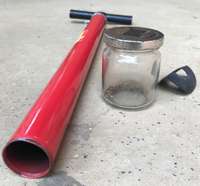
Feeds – Farm-Generated Feeds Research
Research and farm staff recently completed phase one of ongoing ‘farm-generated feeds’ trails for pigs. Pigs given feed produced on the farm using fermented banana stem silage and other other locally resourced maerials were compared to pigs fed only commercial feed. Trials looked at cost of feed, weight gain of pigs, and potential economic returns. Results from this initial comparison of farm-generated feed are summarized HERE and represent the adaptive research that we hope to continue doing. Coming research will expand these trials to that of poultry and fish production, again using farm-generated feeds.
Opportunities to Engage with the New Farm?
ECHO Asia seeks to equip its network partners with practical ‘know-how’ and ‘do-how’ techniques that may empower more effective outreach to farming communities, households, and families. As such, the ECHO Asia Farm has begun hosting a range of training opportunities for individual development workers and groups from like-minded organizations. Leveraging this farm as a living outdoor classroom, ECHO Asia will be hosting a number of hands-on training opportunities in 2020 and for many years to come.
Half-Day Educational Tours provide exposure and an overview of various sustainable agriculture practices and appropriate technologies housed at the ECHO Asia Farm.
One-Day Trainings are designed to provide participants with an overview of select topics offered by the ECHO staff, specifically related to areas of Soils, Seeds, and Feeds, as well as broader Community Development topics requested by partners.
Three to Five Day Trainings provide participants an opportunity to receive more in-depth training on the aforementioned topics, and additional focus areas requested by network members.
The Asia National Internship Program is available to Asia nationals for 2-6 months to train with, and work alongside, the ECHO staff in on-going projects and initiatives. To learn more about these opportunities, please contact us.
For those wishing to visit the ECHO Asia Farm for a tour or training event, please go to ECHOcommunity.org/events to register or fill out our Needs Assessment form to begin the process of responding and planning for a special request for your group/team.
This map below can guide local drivers to our location. You can also CLICK HERE to be directed to the Google Maps link.
Take-Home Message
The ECHO Asia Farm exists, first and foremost, for the benefit of the network of partners in which we serve. It is therefore our hope that each of you will have an opportunity to one day visit us and take advantage of this amazing living classroom. We welcome you here, and wish to see this place used as a regional hub for the training and resourcing of those seeking to find sustainable hunger solutions.
